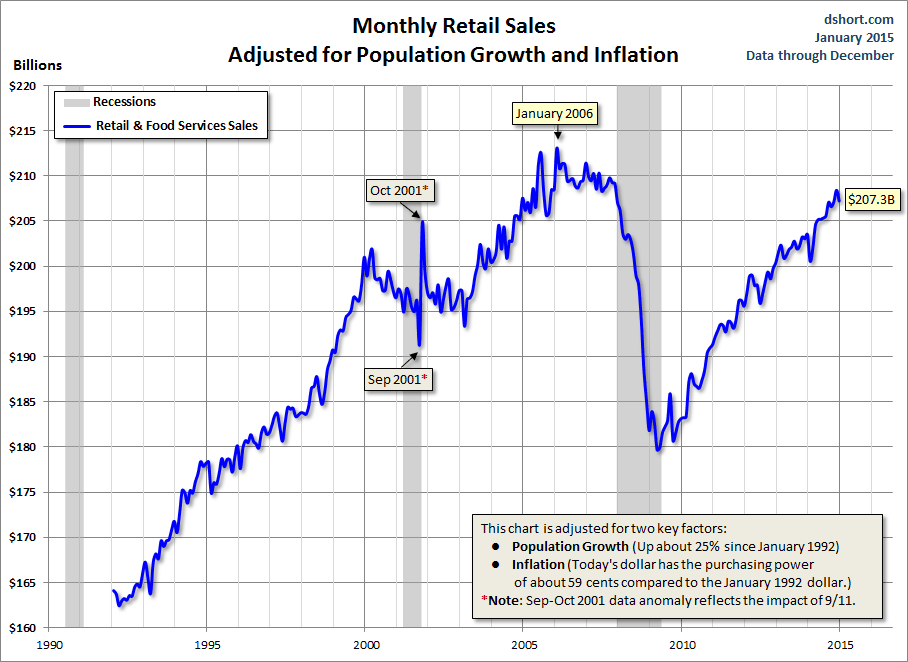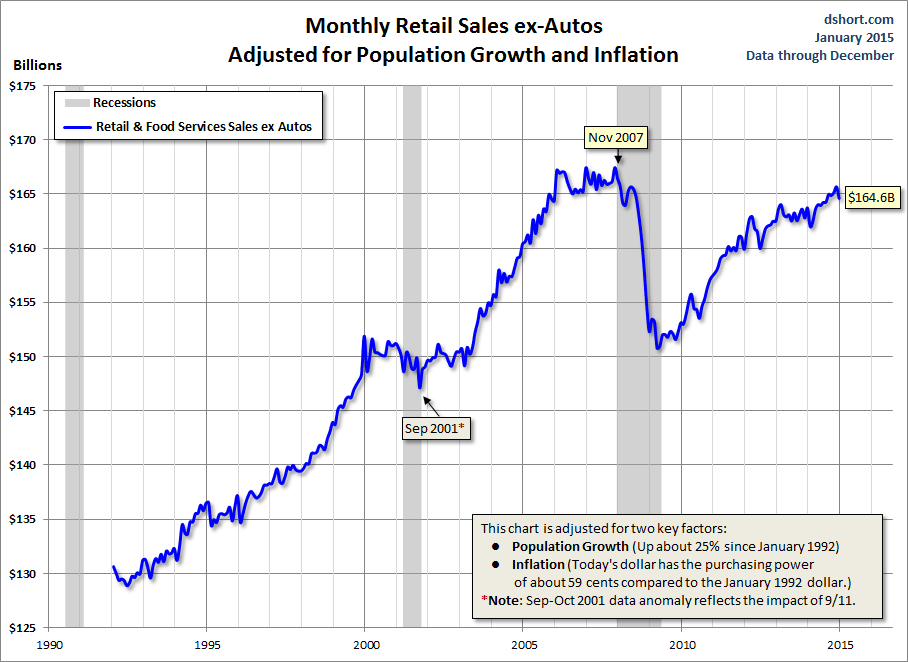I’m sure you won’t get this perspective from the faux financial “journalists” on CNBC and Rupert Murdoch’s rags or neo-con networks. Meanwhile, the brilliant CEO’s of mega-retailers across the land have added 3 billion square feet of retail space since 2000.
Guest Post by Doug Short
Real Retail Sales Per Capita: Another Perspective on the Economy
In real, population-adjusted terms, Retail Sales are at the level we first reached in September 2004.
Last week the Advance Retail Sales Report showed that sales in June rose 0.2% month-over-month and 4.2% year-over-year, as I reported in my real-time update.
With today’s release of the Consumer Price Index, we can now dig a bit deeper into the “real” data, adjusted for inflation and against the backdrop of our growing population.
The first chart shows the complete series from 1992, when the U.S. Census Bureau began tracking the data in its current format. I’ve highlighted recessions and the approximate range of two major economic episodes.
The Tech Crash that began in the spring of 2000 had relatively little impact on consumption. The Financial Crisis of 2008 has had a major impact. After the cliff-dive of the Great Recession, the recovery in retail sales has taken us (in nominal terms) 15.7% above the November 2007 pre-recession peak to a record high.
Here is the same chart with two trendlines added. These are linear regressions computed with the Excel Growth function.
The green trendline is a regression through the entire data series. The latest sales figure is 4.0% below the green line end point.
The blue line is a regression through the end of 2007 and extrapolated to the present. Thus, the blue line excludes the impact of the Financial Crisis. The latest sales figure is 18.8% below the blue line end point.
We normally evaluate monthly data in nominal terms on a month-over-month or year-over-year basis. On the other hand, a snapshot of the larger historical context illustrates the devastating impact of the Financial Crisis on the U.S. economy.
The “Real” Retail Story: The Consumer Economy Remains at a Recessionary Level
How much insight into the US economy does the nominal retail sales report offer? The next chart gives us a perspective on the extent to which this indicator is skewed by inflation and population growth. The nominal sales number shows a cumulative growth of 166.7% since the beginning of this series. Adjust for population growth and the cumulative number drops to 113.9%. And when we adjust for both population growth and inflation, retail sales are up only 25.0% over the past two-plus decades. With this adjustment, we’re now at a level we first reached in September 2004.
Let’s continue in the same vein. The charts below give us a rather different view of the U.S. retail economy and the long-term behavior of the consumer. The sales numbers are adjusted for population growth and inflation. For the population data I’ve used the Bureau of Economic Analysis mid-month series available from the St. Louis FRED with a linear extrapolation for the latest month. Inflation is based on the latest Consumer Price Index. I’ve used the seasonally adjusted CPI as a best match for the seasonally adjusted retail sales data. The latest retail sales with the dual adjustment declined 0.1% month-over-month, and the adjusted data is only up 1.4% year-over-year.
Consider: Since January 1992, the U.S. population has grown about 25% while the dollar has lost about 42% of its purchasing power to inflation. Retail sales have been recovering since the trough in 2009. But the “real” consumer economy, adjusted for population growth is 3.7% below its all-time high in January 2006.
As I mentioned at the outset, nominal month-over-month retail sales were up 0.2%. Let’s now examine Core Retail Sales, a version that excludes auto purchases.
By this analysis, adjusted Core Retail Sales were up 0.1% in June from the previous month, up only 0.9% year-over-year and down 1.8% from its record high in November 2007.
The Great Recession of the Financial Crisis is behind us, a close analysis of the adjusted data suggests that the recovery has been frustratingly slow. The reality is that, in “real” terms — adjusted for population growth and inflation — consumer sales remain below the level we saw at the peak before the last recession.








but we have had 5 years of recovery!
Now add in the debt factor – as in retail sales in 1980 weren’t financed by debt and nobody I knew ever put their utilities, house payments, or groceries on credit, which is much more common now.
Now add in the dramatic increases in federal and state transfer payments, how much of those charts are 100% due to the flow of fiat from WDC to the “poor” (sidenote, I’ve often wondered how much Coke & Pepsi’s sales would fall if SNAP were no longer allowed to buy soda and Doritos).
The real economy, the economy of wealth production and upward mobility for the masses, has shrunk worse than even these charts show us.
But day-um, hasn’t the destruction of both our dollar and our manufacturing base been sweetly covered up by these stats?
I look around, do a few quick accounting entries in my head, and I can tell you there is NO WAY our GDP is an actual reflection of our inner economy. A car made up of ZERO American made parts, but assembled by one overpaid workforce and the sales counted at $40k (when no such money ever exists, the beauty of leasing), is counted as $40k.
20 years ago that car was chock full of American parts that didn’t show up in GDP, but sure as hell appeared in local jobs, charity and opportunities.
Our GDP better reflects the top 0.1%, the gubment, and Asia’s economy than our own.
Is it just me, or do see sheeple just going through the motions nowadays. I really don’t think it takes a rocket scientist to know that this economy is just a shell of what it was once as recently as the early 2000’s. A few folks still living way beyond their means, but for the most part, and this is just anecdotal, I just see people, buying necessities. I really think once you get out of NYC, and San Fran, and maybe a few other places, you actually see what is really going on– the getting to be 3rd world rural towns and villages with 50% unemployment or underemployment. You get to the brain dead suburbs around the major cities which are themselves nothing more than high rise office parks with no vitality. I don’t mean to ramble, but this country is so screwed. It would be really really nice to have one little REAL green shoot to get excited about but I just don’t see it. Out.
I’ll add this to admin’s chart-a-palooza
pretty much says it all. The average joe is screwed, the rich are getting much richer (at least on paper).
[img [/img]
[/img]
Doug writes “The Great Recession of the Financial Crisis is behind us, a close analysis of the adjusted data suggests that the recovery has been frustratingly slow.”
I get a kick out of Doug – it’s like he really believes the BS numbers published by the gubmint. Every number out there is BS. Q1 GDP was reported as +0.1% to push another daily rally but then quietly revised down to -3%. It’s truly pathetic.
The local eye test indicator tells me all I need to know about the plight of retail. Got this the other day from a big regional retailer in or area, 350 stores from the West Coast to the Midwest:
Coldwater Creek files for bankruptcy, will close stores
Tom Sowa The Spokesman-Review
Coldwater Creek Inc., the Sandpoint clothier that blended women’s apparel and lifestyle into a successful venture, filed for bankruptcy Friday.
The company plans to sell off inventory at a discount, shutter its 350 stores, and erase the jobs of 5,500 people, including 340 in Sandpoint and 110 in Coeur d’Alene.
The company launched by Dennis and Ann Pence in 1984 as a catalog business grew into a nationwide clothing retailer with stores, day spas and glossy catalogs with models sporting women’s fashions, accessories and gifts.
But the recession and a ruthlessly competitive retail apparel sector left Coldwater Creek reeling for the past seven years. The company trimmed costs, cut the number of employees and closed stores for the past two years yet continued to lose money.
Company executives said Friday they were unable to find a buyer or an investor to keep the business afloat.
The company’s bankruptcy filing in the U.S. Bankruptcy Court in Delaware lists assets worth $278.5 million and debts of $361.3 million.
“Making the announcement today has been a very difficult process,” said Jim Bell, Coldwater Creek’s chief operating officer. “On top of all the feelings, I am extremely grateful to every one of our associates and employees.”
Most employees will continue working for up to 60 more days and receive paychecks for that period. A number of employees will be retained beyond 60 days to help wind down the operations.
I just went to the store. Bought cat food, vodka, and toilet paper.
I’m all set.
For any of you who need to manage your FRNs carefully, I recommend an online budgeting program called You Need a Budget (ynab.com). After trying it free for 34 days, I was happy to fork over $60 bucks for the software. You should check it out. It works so well for me that I am startled to find myself actually having extra money at the end of the month, rare for me. I’ll be able to send Admin a check after all.
You Know It’s The New Normal When…
Submitted by Tyler Durden on 07/24/2014 21:43 -0400
The housing market is once again rapidly cooling off, as the fourth dead cat bounce of the artificial, centrally-planned “recovery” of the last 5 years takes hold (nowhere more visibly than in Phoenix whose “Housing market has been hit an unprecedented plunge in demand”) but it wouldn’t be the New Normal in which the middle class is evaporating at an unprecedented pace in order to make the uber rich uber-richer, if it wasn’t for stories such as this about one particular real estate market: that favorite haunt of the 0.001%, the Hamptons:
A separate report from the Corcoran Group showed that luxury sales by dollar volume rose 11 percent in the second quarter. Susan Breitenbach, a Corcoran broker who worked with Folise, said she has $200 million in sales and contracts so far this year, on pace to eclipse her typical yearly volume of $250 million.
Tim Davis, another Corcoran broker, recently sold Wooldon Manor, a 14.5-acre (6-hectare) estate in Southampton, in two parcels for a combined $80 million. The seller was Scott Bommer, president of hedge fund SAB Capital Management LP, who paid $75 million for the oceanfront property in December.
A mere $5 million in 6 months? What bubble…
But wait, there’s more, and this one is even more to the point:
•CHUBB HAS SEEN UPTICK IN YACHT PURCHASING, MEGA-YACHT BUSINESS
Maybe Obama can explain to Steve Liesman once again just how the recovery is trickling down to the ordinary American simply because the market is hitting new all time highs on a daily basis.
Actually, in retrospect, there nothing “new” about this “new” normal at all, or rather, abnormal.
I shudder to think what Doug Short’s charts would look like if he ran the real cost-of-living figures from Shadowstats.